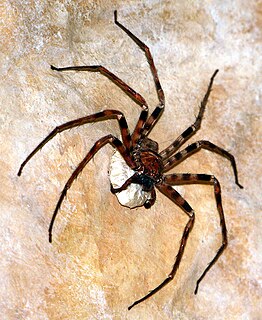
Scaffold web spiders (Nesticidae) is a family of araneomorph spiders closely allied with tangle web spiders. Like the "Theridiidae", these spiders have a comb of serrated bristles on the hind tarsi that are used to pull silk bands from the spinnerets. It contains 16 genera and about 300 species, many of which are associated with caves or overhangs. The genus Nesticus is the type for the family and is found throughout the world. The related Eidmannella has speciated considerably in Texas caves and includes some extremely localized species that are considered threatened. One species, Eidmannella pallida, is found in caves and under overhangs, but also in agricultural fields and other habitats away from such restricted areas. The genus Carpathonesticus is found in central Eurasia.

Kabouter is the Dutch word for gnome or leprechaun. In folklore, the Dutch Kabouters are akin to the Irish Leprechaun, Scandinavian Tomte or Nisse, the English Hob, the Scottish Brownie and the German Klabauter or kobold.

Ochyroceratidae is a six-eyed spider family, with 165 described species in ten genera. They are common inhabitants of caves and the tropical forest litter of South Africa, the Caribbean, Asia and South America. Considered an ecological counterpart of the Linyphiidae of the northern temperate zone, species are especially diverse in the Indo-Pacific region.

The giant huntsman spider, found in Laos, is a species of huntsman spider (Sparassidae), a family of large, fast spiders that actively hunt down prey. It is considered the world's largest spider by leg span, which can reach up to 30 cm (1 ft).
Sinopimoa is a monotypic genus of Chinese sheet weavers containing the single species, Sinopimoa bicolor. It was first described by S. Q. Li & J. Wunderlich in 2008, and is found in China. It was originally placed in its own family (Sinopimoidae) but is now considered a member of the Linyphiidae, and it may be a member of the Erigoninae.
Walter De Donder is a Belgian actor and politician and is best known for parts in Flemish children's television series.
Troglohyphantes vignai is a species of cave spider of the family Linyphiidae. It is endemic to Italy.
Troglohyphantes nigraerosae is a species of cave spider of the family Linyphiidae. It is endemic to Italy.
Tennesseellum gollum is a species of spider in the family Linyphiidae. The species is named after the fictional character Gollum from the works of J. R. R. Tolkien, in reference to "the 'evil look' of the male of this species due to the large cheliceral tubercles." Native to the Southwestern United States, it was described based on an individual collected in Anza-Borrego Desert State Park, Southern California.
Epiceraticelus is a genus of North American dwarf spiders containing two species: Epiceraticelus fluvialis and Epiceraticelus mandyae. The first described species in the genus, E. fluvialis, was first described by C. R. Crosby & S. C. Bishop in 1931, and has only been found in the Midwestern and Eastern United States. The second species, E. mandyae, was described in 2019 by M. L. Draney et al. and occurs in the Southeastern United States from Eastern New Jersey south to Georgia and west to Louisiana. The male of E. mandyae has a curved proboscis that extends from below the eyes. Epiceraticelus mandyae was named after the late arachnologist, Amanda Howe, in honor of her contributions to the North American arachnology community.
Esophyllas is a genus of North American dwarf spiders that was first described by T. R. Prentice & R. A. Redak in 2012. As of May 2019 it contains only two species, both found in the United States: E. synankylis and E. vetteri.
Houshenzinus is a genus of East Asian dwarf spiders that was first described by A. V. Tanasevitch in 2006. As of May 2019 it contains only three species, found in China: H. rimosus, H. tengchongensis, and H. xiaolongha.
Platyspira is a monotypic genus of East Asian sheet weavers containing the single species, Platyspira tanasevitchi. It was first described by Y. J. Song & S. Q. Li in 2009, and has only been found in China.
Shanus is a monotypic genus of East Asian sheet weavers containing the single species, Shanus taibaiensis. It was first described by A. V. Tanasevitch in 2006, and has only been found in China.
Taibainus is a monotypic genus of East Asian sheet weavers containing the single species, Taibainus shanensis. It was first described by A. V. Tanasevitch in 2006, and has only been found in China.
Taibaishanus is a monotypic genus of East Asian sheet weavers containing the single species, Taibaishanus elegans. It was first described by A. V. Tanasevitch in 2006, and has only been found in China.
Tapinotorquis is a monotypic genus of North American sheet weavers containing the single species, Tapinotorquis yamaskensis. It was first described by N. Dupérré & P. Paquin in 2007, and has only been found in Canada and the United States.
Ternatus is a genus of East Asian sheet weavers that was first described by N. Sun, B. Li & L. H. Tu in 2012. As of May 2019 it contains only two species, both found in China: T. malleatus and T. siculus.
Erigomicronus is a genus of dwarf spiders first described by A. V. Tanasevitch in 2018. As of April 2019 it contains only two species.



